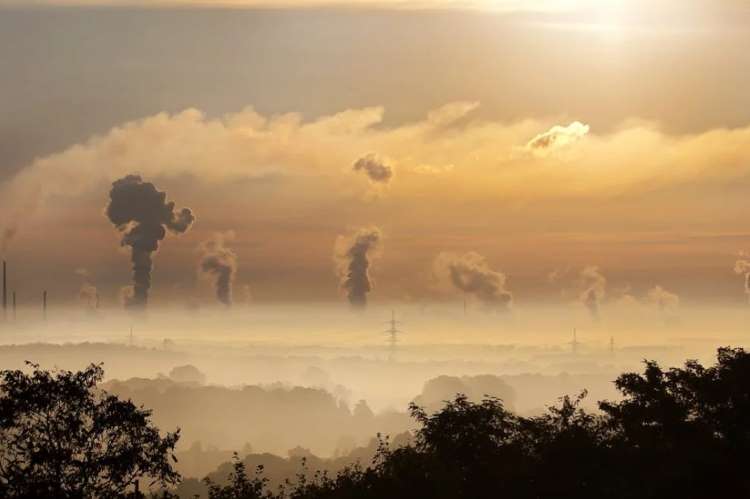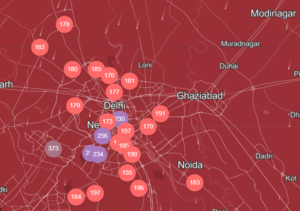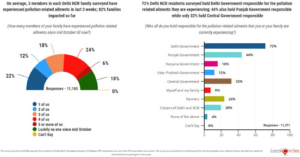
Delhi’s air pollution crisis: India ranked third in air pollution among 134 countries last year, according to IQAir, signalling grave concerns about deteriorating air quality. Delhi, India’s bustling capital, has faced a severe air pollution crisis for years. The hazardous air quality index and increased health risks for residents call for urgent attention and effective policy solutions.
Stubble burning in Northern India, particularly in states like Punjab and Haryana, has become a recurring issue, contributing significantly to Delhi’s air pollution. This practice leads to the city experiencing days with emergency-level air quality. Indian scientists have explored cloud seeding as a potential method to alleviate the smog in Delhi, but despite these efforts, the air quality problem persists. The continuous reliance on traditional agricultural practices like stubble burning highlights the need for sustainable solutions and interventions at both local and regional levels.

The report highlighted that Northern India, particularly Delhi, suffers from smoke due to stubble burning, vehicular emissions, coal combustion, waste burning, and unchecked construction activities in the Delhi-NCR area. Stubble burning annually leads to emergency-level air quality in Delhi. Indian scientists have considered cloud seeding as a potential remedy for Delhi’s smog, yet the problem remains persistent.
READ I Delhi’s air pollution is extracting a huge socioeconomic cost
Understanding Delhi’s air pollution crisis
Delhi’s air pollution crisis stems from various sources: vehicular emissions, industrial pollution, construction activities, crop burning, and dust particles. These sources significantly contribute to the city’s air contamination, posing severe health risks, including respiratory diseases and heart conditions, and reducing life expectancy. In 2023, PM2.5 levels in Delhi increased by 10%, peaking in November at an average of 255 µg/m³.
The major source of Delhi’s air pollution is vehicular emissions. The city had 1.50 crore registered vehicles in 2021, underscoring the need for regular maintenance and Pollution Under Control (PUC) checks. PUC certification indicates that a vehicle’s emissions comply with pollution norms and are not environmentally harmful. However, the surge in vehicles has significantly worsened the city’s pollution levels.

Stubble burning in neighbouring states like Punjab, Haryana, and parts of Western Uttar Pradesh also aggravates Delhi’s air quality. The city’s air quality index worsened significantly in 2023, emphasising the need for effective solutions.
Delhi’s air pollution crisis has severe health consequences. Studies have linked exposure to PM2.5 with an increased risk of respiratory illnesses like asthma, bronchitis, and lung cancer. It can also worsen existing heart conditions, leading to heart attacks and strokes. Children, pregnant women, and the elderly are particularly vulnerable to these health risks.
Beyond the human cost, air pollution also imposes a significant economic burden. It leads to increased healthcare expenses, lost productivity due to illness, and even impacts tourism. A study by the World Bank estimated that air pollution costs India billions of dollars annually.
While traditional solutions like vehicle emission control and industrial regulations remain crucial, there are promising advancements on the horizon. Research on bio-decomposers offers a potential solution to stubble burning, breaking down crop residue without resorting to fire. Additionally, air filtration technologies like urban greening projects and smog towers are being piloted to improve air quality in specific areas.
Possible solutions to the problem
Addressing air pollution necessitates a blend of technology and political resolve. A comprehensive approach is crucial, involving the promotion of electric vehicles through subsidies and tax incentives, enhancing public transportation to reduce private vehicle use, and implementing strict emission controls for commercial vehicles.
Additionally, promoting renewable energy sources like solar and wind power, investing in industrial pollution control measures, and advocating for sustainable construction practices are vital. Addressing agricultural practices, such as crop burning, with financial aid to encourage farmers to adopt eco-friendly methods like organic farming or mechanised sowing is essential. Implementing these measures can help Delhi’s residents foster a cleaner, healthier environment for current and future generations.
Collaborative governance is vital, requiring the involvement of government, experts, communities, NGOs, and scientific institutions to formulate robust policies. Public awareness campaigns should highlight the severity of air pollution and encourage greener practices. Strict enforcement, supported by effective monitoring, is essential to ensure regulatory compliance and penalise violators.
Delhi’s air pollution crisis represents a public health disaster and a threat to environmental sustainability. The proposed policy solutions, including reducing vehicular emissions, promoting renewable energy, tackling industrial pollution, encouraging sustainable construction, and addressing crop burning, offer a comprehensive approach to mitigating the issue. Through these measures and coordinated efforts, Delhi can move towards achieving cleaner, healthier air for its citizens and future generations.
(Dr Md Mashhood Alam is a senior research associate with BRCG Research & Development Foundation.)
